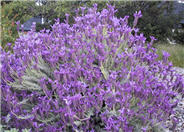
Common name:Strawberry Madrone, Marina Strawber
Botanical name:Arbutus 'Marina'
The 'Marina' has gorgeous bark, with leaves that are smaller and not as glossy as Pacific Madrone. Its flowers are pink, borne in pendant clusters in the summer. The fruit is large, red and quite ornamental. The plant should be grown in sun to part shade, with little or no summer watering when established. The 'Marina' prefers good drainage. -Monterey Bay Nursery

Common name:New Zealand Flax
Botanical name:Phormium tenax 'Atropurpureum'
Phormium tenax 'Atropurpureum' is an evergreen perennial. Big, dramatic plant composed of many swordlike, stiffly vertical leaves (9 ft. long, to 5 in. wide) in a fan pattern. Leaves are purple red. Flowers stems reach high above leaves, bearing clusters of 1-2 in. blossoms in dark red to yellow.

Common name:Yarrow Moonshine
Botanical name:Achillea 'Moonshine'
Pale yellow flowers appear to float on long, slender stems. Leaves are green to gray-green leaves, which are flatter and less divided than those of the Achillea millefolium. Yarrows propagate easily from rooted cuttings or division, which should be perfo Yarrows propagate easily from rooted cuttings or division, which should be performed in the early spring or fall. Following bloom, one should dead head the plant and divide the clumps when it appears crowded.

Common name:Wheeler's Dwarf Pittosporum
Botanical name:Pittosporum tobira 'Wheeler's Dwarf'
This handsome dwarf form of the Pittosporum tobira grows into a low, dense mound that is covered with glossy, evergreen foliage.

Common name:Spanish Lavender
Botanical name:Lavandula stoechas
This dense shrub grows 2-3 ft. tall with blue gray foliage and deep purple flowers that have large showy bracts near the top of the spikes. It is drought tolerant . - Cornflower Farms

Common name:Murphy's Agave
Botanical name:Agave murpheyi
This is a medium-sized agave to about 3' tall and wide. The blue-green to grey-green leaves show striking bud imprints of the surrounding leaves. This agave tolerates extreme heat and full sun with minimal supplemental irrigation. This form was domesticated by Native Americans for the sugary heart at blooming. Similar to Agave americana but with smaller scale. Pups will fill in after parent dies.-Mountain States Nursery

Common name:Common Yarrow, Milfoil
Botanical name:Achillea millefolium
Highlighting this perennial are spreading mats of fern-like rosettes, along with deeply divided leaves of a green or grey green color. In this form, the flowers are usually a white tone. Stems can reach 2-3ft above foliage. The yarrow propagates easily from rooted cuttings or division, which should be performed in the early spring or fall. Following bloom, one should dead head the plant and divide the clumps when it appears crowded.

Common name:Red Cross Kangaroo Paws
Botanical name:Anigozanthos 'Red Cross'
Red Cross Kangaroo Paws has showy, tall (4'-5'), multi- branched stems with rich red color on both flowers and stems. The flowers have a green interior. It is fast growing.

Common name:Eulalia or Maiden Grass
Botanical name:Miscanthus sinensis 'Gracillimus'
The 'Gracillimus' is a taller variety, often growing to 6-8' tall with delicate feathery plumes and very thin graceful leaves. It should receive sun to part shade, and average to little summer watering. -Monterey Bay Nursery
M

Common name:Trailing Germander
Botanical name:Teucrium X lucidrys
This mini-shrub with small, shiny, dark green leaves on woody stems can be sheared and shaped. The stems trail and rise to 24", with lovely reddish-purple flowers between the upper leaves. It can be used as a low hedge plant in herbal knot gardens. To encourage branching, it should be pruned in the spring. -Holland WIldflower Farm
| Designer: Barbara Jackel Landscape Dsgn | Feast for the Eyes |
Photographer: GardenSoft |
Soils and Compost:
Maintain a two to four inch layer of mulch on the soil surface to reduce weeds, infiltrate rain water, and reduce compaction.
Water Saving Tip:
Use water saving equipment, e.g. rain or soil-moisture sensors, MP rotator nozzles, weather-based controllers, and low-volume irrigation (drip systems, soaker hoses, and microsprayers).
Integrated Pest Management:
Remove irrigation water and fertilizer from areas where you don't want weeds to grow.

